Florida is one of the most diverse states in the United States, with many different habitats that are home to thousands of different species. Central Florida is just as diverse as the rest of the state and is known for its hot and humid summers and dry winters. This climate creates the perfect conditions for snakes. Although there are more than 50 species of snake that call Florida home, there are 35 species in Central Florida alone, including four of the six venomous species and one of the five species of non-native snakes. So, join us as we discover some of the snakes in Central Florida!
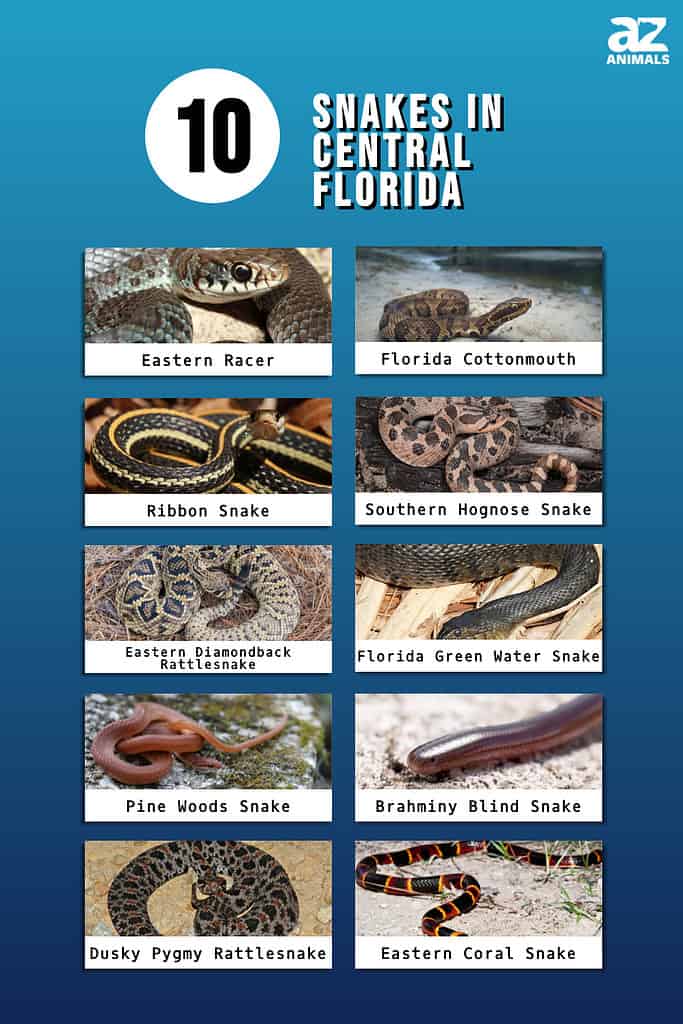
1. Eastern Racer
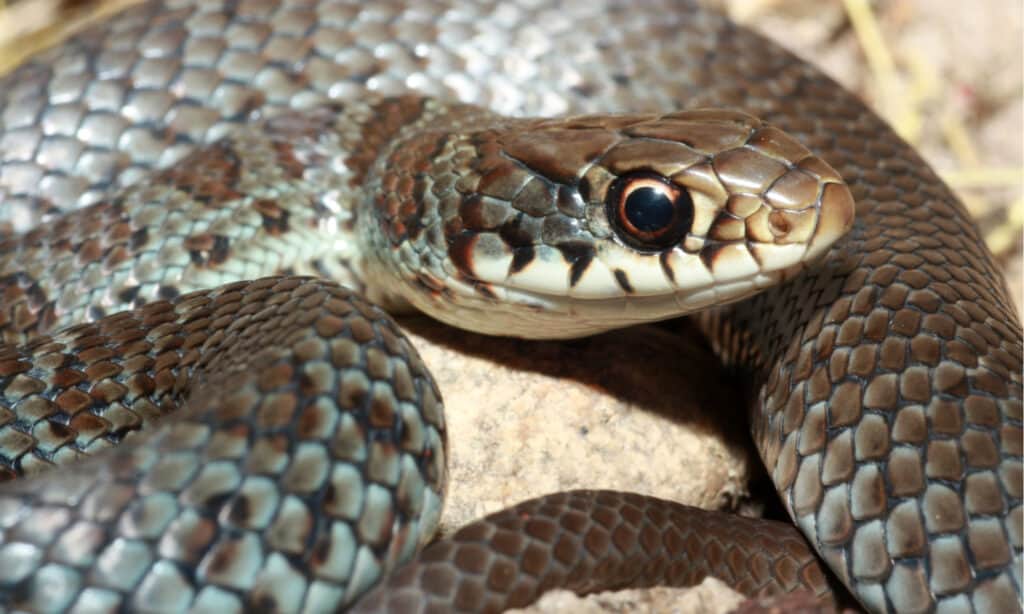
Eastern racers are the most common snakes found in residential areas.
©Michael Benard/Shutterstock.com
There are eleven subspecies of eastern racers, and three of them are found in Florida. They are 20 to 60 inches long and are typically bluish-black with white markings underneath their chins. These snakes are fast and agile, with keen eyesight, and are most active during the day. They live in a variety of habitats and are one of the most common snakes seen in residential areas. Eastern racers are excellent climbers and often raid bird nests for eggs and chicks. They also eat rodents, frogs, lizards, and other snakes. Despite their scientific name, Coluber constrictor, eastern racers are not true constrictors and typically overpower their prey before swallowing it alive.
2. Florida Cottonmouth
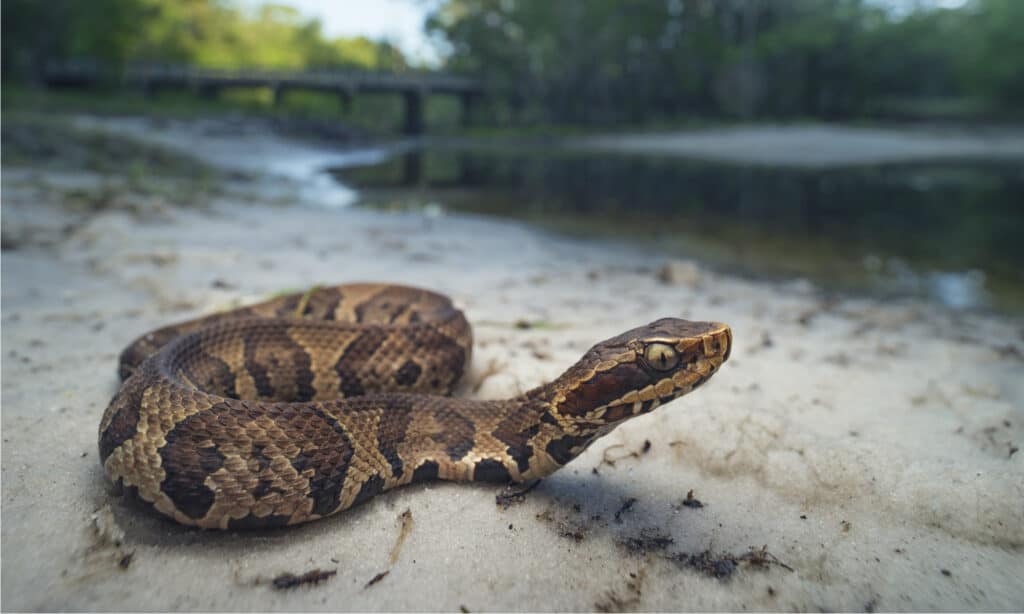
Venomous cottonmouths are found in virtually every wetland habitat.
©Kristian Bell/Shutterstock.com
The first of the four venomous snakes in Central Florida is the Florida cottonmouth. Cottonmouths are 30 to 48 inches long and are brown, with a mixture of light and dark brown crossband markings. They live near virtually every wetland habitat but are not limited to only freshwater as they can be found in brackish water and near offshore islands. However, despite this, they can also be found up to a mile away from water too. Florida cottonmouths are opportunistic feeders and eat anything they can catch — such as fish, lizards, birds, frogs, and other snakes (including fellow cottonmouths). Although they usually only strike as a last resort, they are extremely venomous, and there is around a 17% mortality rate with bites.
3. Ribbon Snake
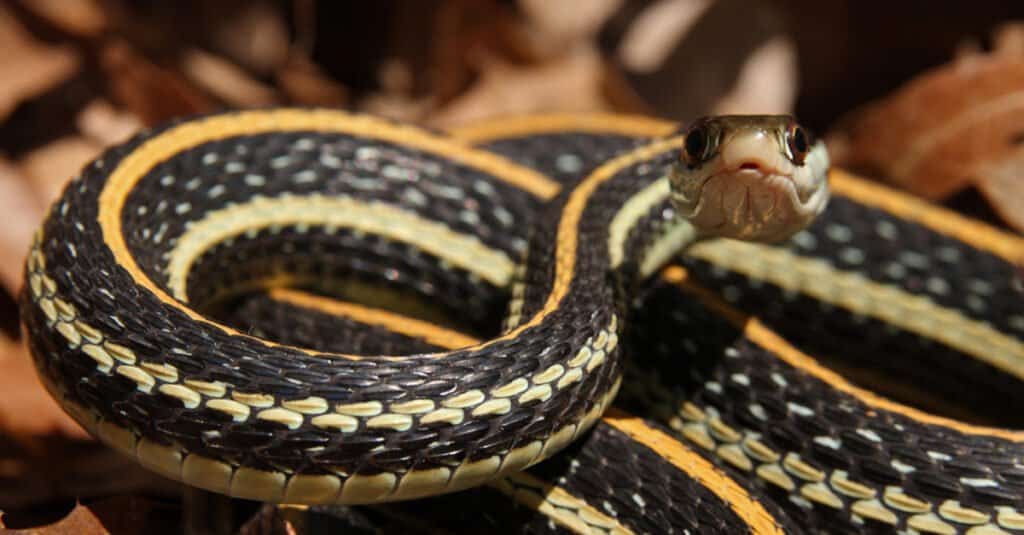
Ribbon snakes are one of the most frequently seen snakes in Central Florida.
©Ryan M. Bolton/Shutterstock.com
There are four subspecies of ribbon snakes, and they are one of the more common snakes in Central Florida. Ribbon snakes are 7 to 34 inches long and get their name from their slender bodies. They are typically black or brown, with thin yellowish stripes running down their back and body. Ribbon snakes are semi-aquatic and live near ponds and streams, where they can be found both in and out of the water. They mate in the spring when they awake from hibernation and give birth to live young in the summer, meaning that they are ovoviviparous. Ribbon snakes do not eat any warm-blooded animals, so their diet is almost entirely made up of fish, frogs, salamanders, spiders, and earthworms.
4. Southern Hognose Snake
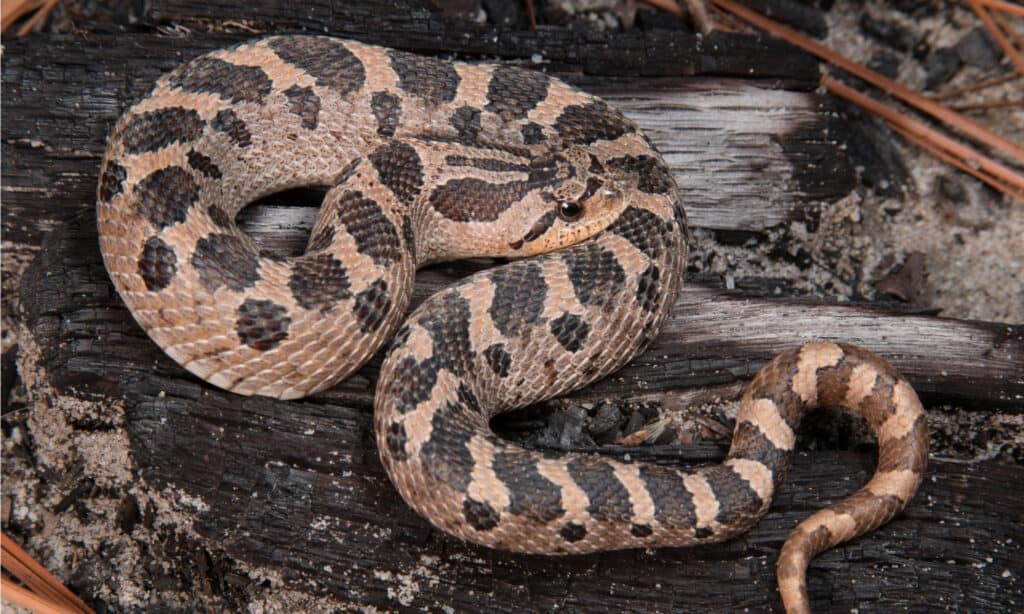
Southern hognose snakes are a vulnerable species in Florida.
©Nathan A Shepard/Shutterstock.com
The vulnerable species on the list is the southern hognose snake. Southern hognose snakes are 14 to 24 inches long and have an unusual appearance. They have a wide neck and a noticeably upturned snout. They are gray, brown, or red with large dark blotches on their bodies. Southern hognose snakes prefer to live in dry, sandy areas such as dry floodplains, fields, sandhills, and flatwoods. Although they produce a mild venom that they use to subdue their prey, they are not dangerous to humans and rarely bite. Their diet includes frogs, toads, and lizards, while their predators include kingsnakes and eastern indigo snakes.
5. Eastern Diamondback Rattlesnake
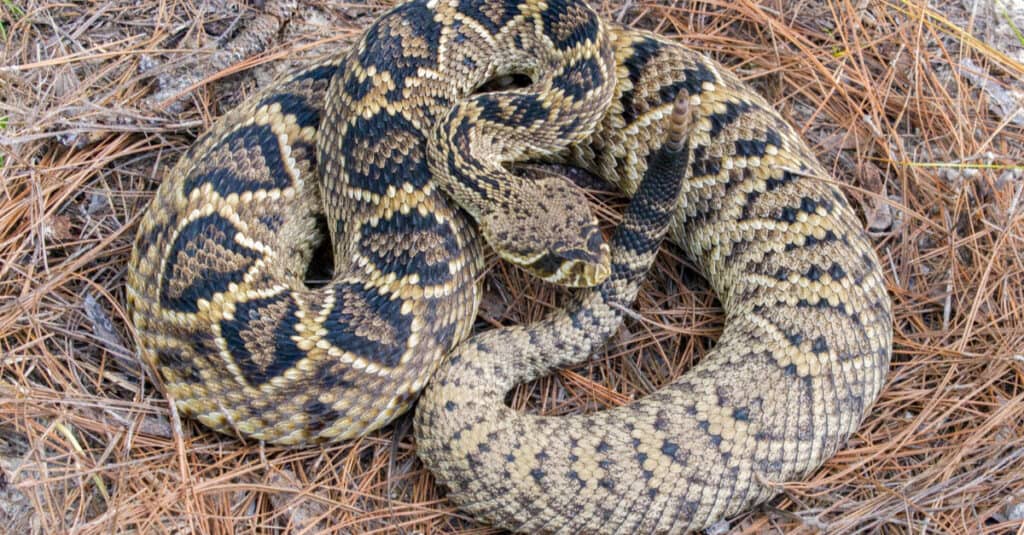
Eastern diamondback rattlesnakes are one of the biggest snakes in Central Florida.
©Chase D’animulls/Shutterstock.com
One of the largest snakes in Central Florida is the venomous eastern diamondback rattlesnake which is typically 3 to 6 feet long. Eastern diamondback rattlesnakes have brownish bodies with diamond-shaped markings on them, which is where they get their name from. They mainly live in pine woodlands, scrubland, and swamps, although they have sometimes been spotted miles from land while crossing between barrier islands. Eastern diamondback rattlesnakes are highly venomous as well as powerful and can make repeated strikes up to two-thirds of their body length. Their diet is mainly rodents, rabbits, and birds, and they have no natural predators.
6. Florida Green Water Snake
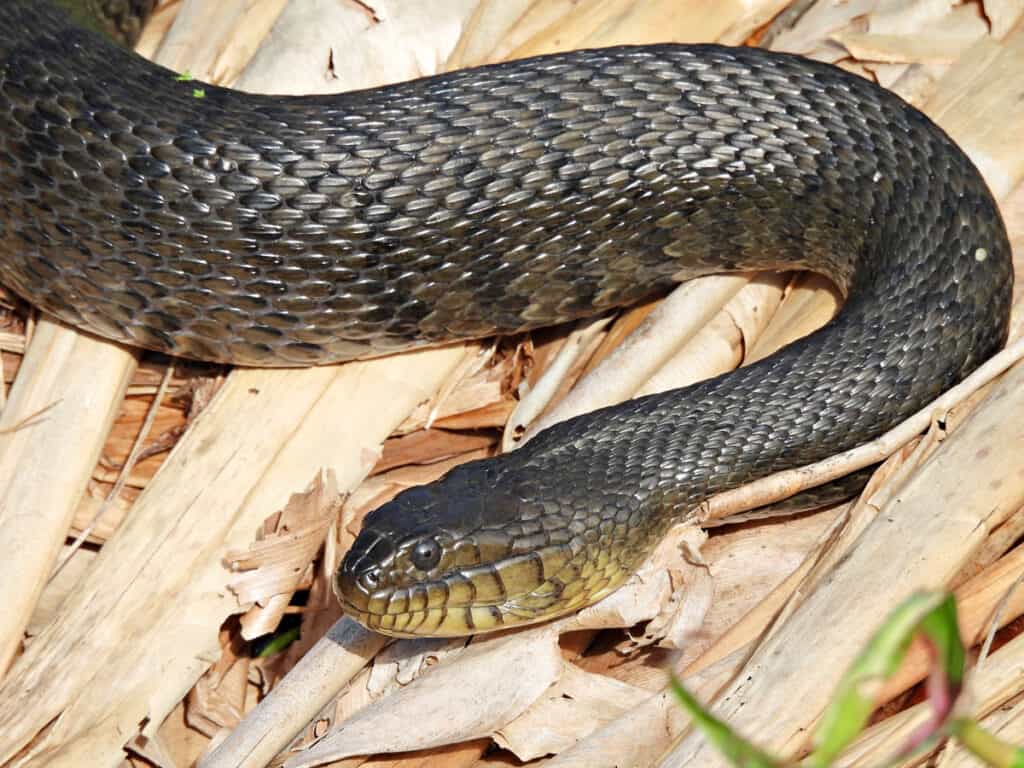
The Florida green water snake can be found all over Florida and has a distinctly large head.
©iStock.com/passion4nature
Although they were originally thought to be a subspecies of green water snakes, Florida green water snakes are an individual species. They are the longest water snakes in North America, reaching 30 to 55 inches long. Florida green water snakes are dark, greenish-brown with dark speckles and lighter bodies. Their favorite habitats are slow-moving water such as ponds, lakes, and swamps where there is plenty of vegetation. Florida green water snakes are not venomous and are not constrictors, and prey is grabbed and swallowed alive. Their diet mainly consists of fish, frogs, tadpoles, and salamanders. They are often mistaken for venomous cottonmouths and killed as a result. Other predators are otters, hawks, kingsnakes, and alligators.
7. Pine Woods Snake
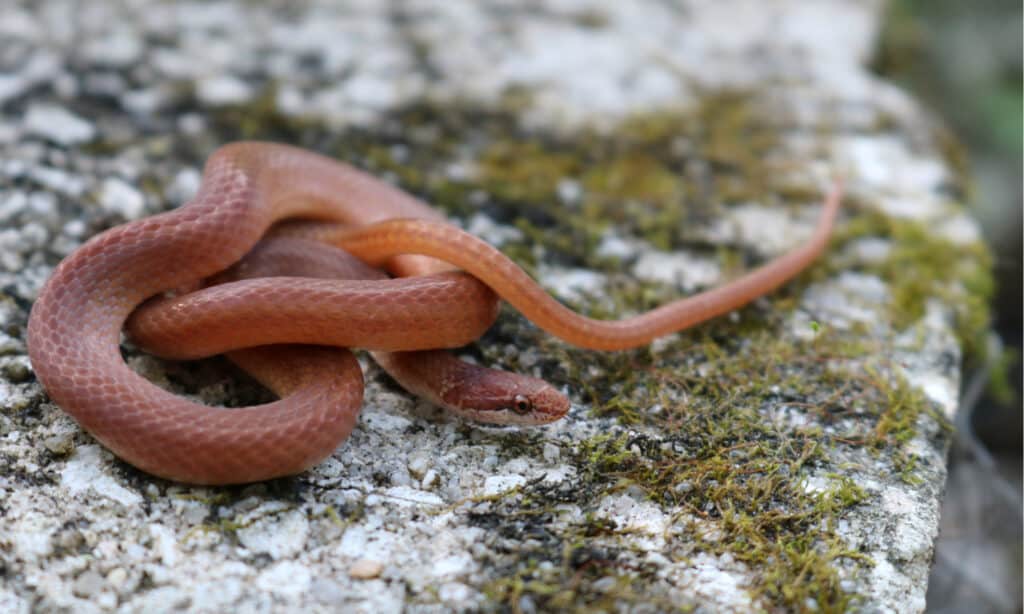
Pine woods snakes are one of the smallest snakes in Central Florida.
©Andrew Jeffries/Shutterstock.com
One of the smallest snakes is the pine woods snake, which only reaches 10 to 13 inches long. Pine woods snakes are reddish-brown with a lighter stripe down the center of their back. They live in pine forests and woodlands where there is plenty of leaf litter or rotten logs for them to hide underneath. They are nocturnal and extremely secretive snakes and are rarely seen; such is their ability to remain hidden. Although pine woods snakes have a very mild venom, they are not considered to be dangerous to humans. They eat lizards, frogs, and salamanders, while their main predators are southern black racers, kingsnakes, and some birds.
8. Brahminy Blind Snake
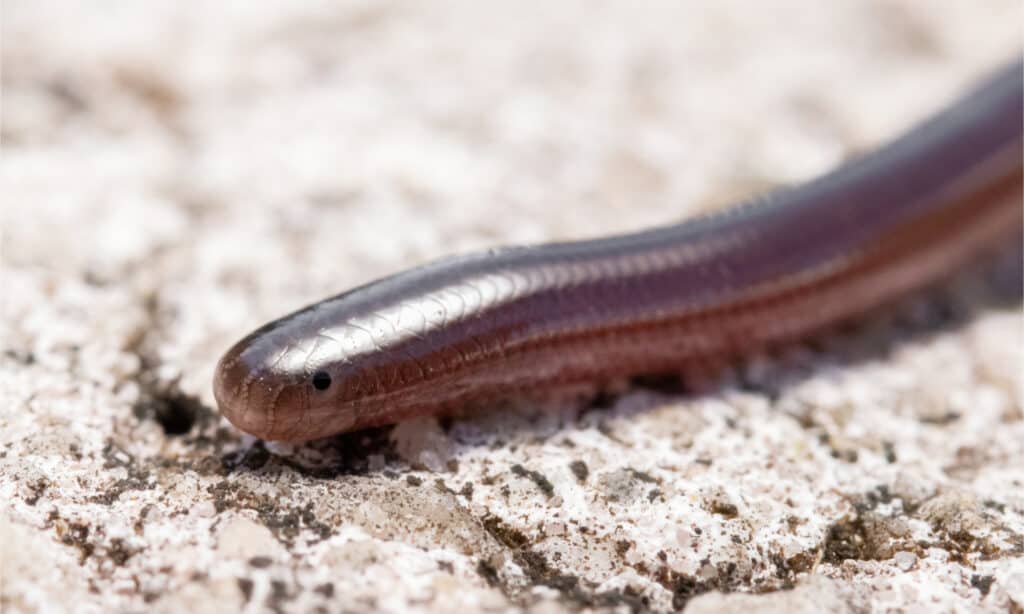
Brahminy blind snakes are the only non-native species of snake in Central Florida.
©Radiant Reptilia/Shutterstock.com
The only non-native snake in Central Florida is the brahminy blindsnake which is also the smallest at only 4.5 to 6.5 inches long. Brahminy blind snakes are native to Africa and Asia and were first introduced to Florida in the 1970s. They are a dark gray or purple color and have thin bodies, which often leads to them being mistaken for earthworms. Both their head and tail are blunt and can make it difficult to distinguish between the two ends. Brahminy blind snakes are excellent burrowers and often live underground in ant and termite nests where they feed on the eggs and larvae. As they are so small, they have many predators, with birds being one of their main predators.
9. Dusky Pygmy Rattlesnake
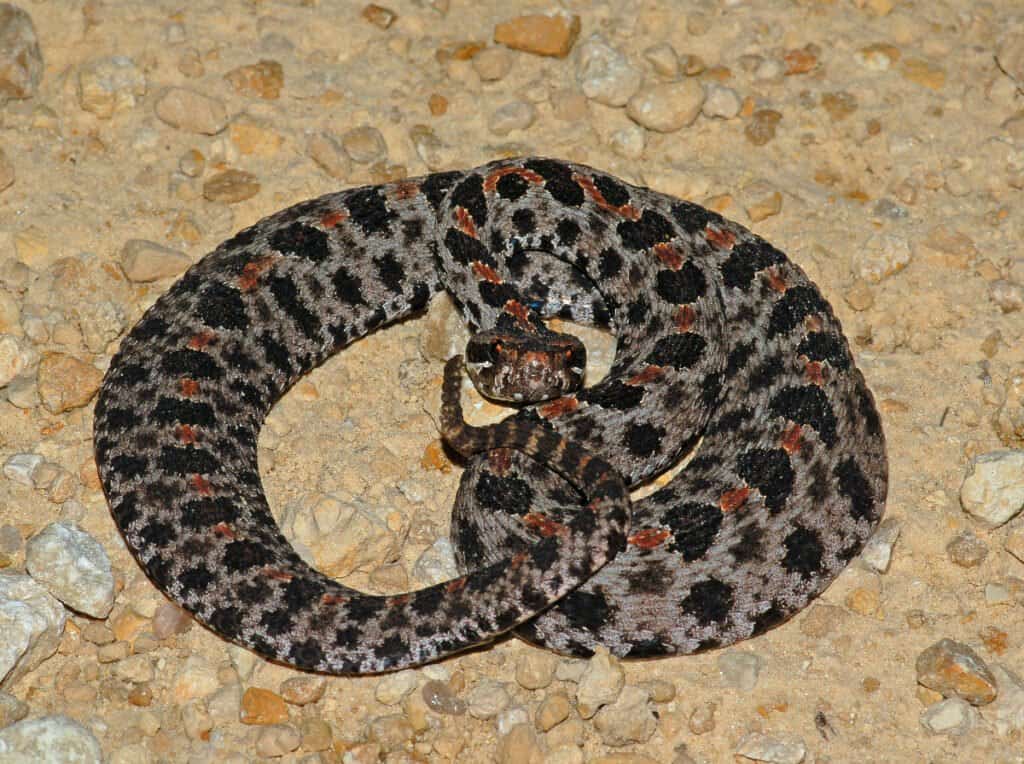
Dusky pygmy rattlesnakes are the smallest venomous snakes in Central Florida.
©Gerald A. DeBoer/Shutterstock.com
One of the smallest rattlesnakes is the dusky pygmy rattlesnake, which is only 12 to 24 inches long. Dusky pygmy rattlesnakes are gray with black blotches and a reddish stripe running down their back. They live in pine flatwoods, prairies, swamps, and near ponds and lakes. Although they are venomous, bites are generally only serious for children. Dusky pygmy rattlesnakes are ambush predators and prey on lizards, frogs, rodents, and other snakes. Their predators include hawks, owls, raccoons, and kingsnakes.
10. Eastern Coral Snake
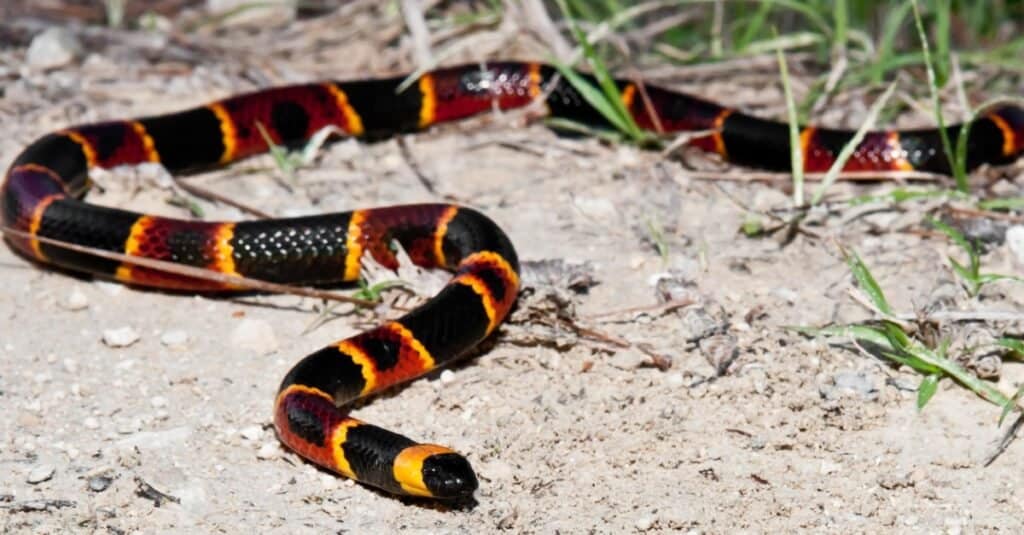
Eastern coral snakes are highly venomous and contain enough venom to kill five people.
©iStock.com/JasonOndreicka
Another venomous snake in Central Florida is the brightly colored eastern coral snake. Eastern coral snakes are 20 to 30 inches long and are red, yellow, and black. They have a similar appearance to non-venomous kingsnakes but are distinguished by their color pattern. These snakes always have red and yellow touching, while kingsnakes have red and black touching. Eastern coral snakes usually live in tropical hammocks and flatwoods, although they are sometimes found in more open areas with less vegetation. They mainly eat frogs, lizards, and other coral snakes. Eastern coral snakes are highly venomous and contain enough venom to kill five people. Thankfully though, they are unable to release it all in one bite!
Other Non-Native Snakes in Florida
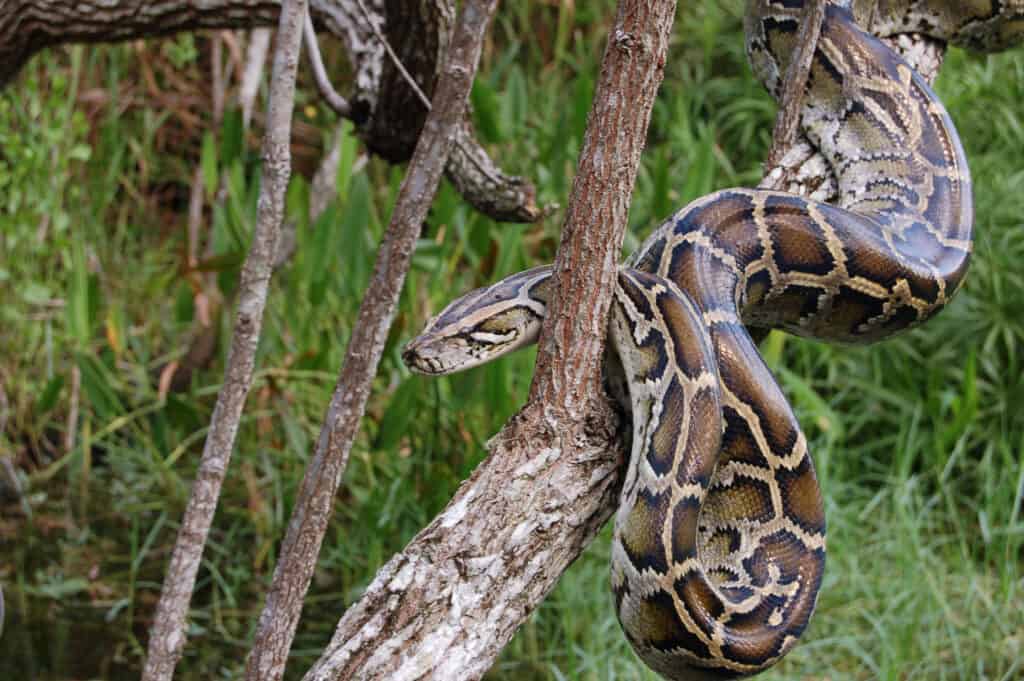
The
Burmese
python is the most invasive snake species in Florida.
©Heiko Kiera/Shutterstock.com
While the only non-native snake in Central Florida is the Brahminy blind snake, which is native to Africa and Asia and introduced to Florida in the 1970s, there are a few more non-native snake species that can be found in other parts of the state.
Easily the most invasive snake species in Florida is the Burmese python, whose presence in the Everglades has been devastating to the native animals and created declines in the populations of raccoons, rabbits, foxes, and bobcats through preying upon them and increasing competition for their food sources. Originating from southeast Asia and thought to have been in the state since 1979 through the release of pet snakes, the Burmese python can grow to 16 feet or more and has no natural predators in its habitat with the exception of any alligators large and powerful enough to survive a battle with the python.
Another invasive snake is the boa constrictor, which can measure 7-13 feet long and adapt to many habitats, with a preference for forests, rivers, swamps, and streams. These snakes are native to South America and the Caribbean and were introduced as exotic pets to Florida in the 1960s and 1970s. Their primary predator is the alligator.
One more invasive snake species in Florida is the African rock python, which is native to sub-Saharan Africa. These pythons can grow to 10-16 feet in length and make their homes in the state’s sawgrass prairies, wetlands, and lake areas. These snakes have been in the wild in Florida since 2002 due to released or escaped pet snakes and like Burmese pythons are present in the Everglades. Find out more about these invasive snake species in Florida here.
Summary of 10 Snakes in Central Florida
| Snake | Venomous or Non-Venomous | |
|---|---|---|
| 1 | Eastern Racer | Non-venomous |
| 2 | Florida Cottonmouth | Venomous |
| 3 | Ribbon Snake | Non-venomous |
| 4 | Southern Hognose Snake | Non-venomous |
| 5 | Eastern Diamondback Rattlesnake | Venomous |
| 6 | Florida Green Water Snake | Non-venomous |
| 7 | Pine Woods Snake | Non-venomous |
| 8 | Brahminy Blind Snake | Non-venomous |
| 9 | Dusky Pygmy Rattlesnake | Venomous |
| 10 | Eastern Coral Snake | Venomous |
Which State Is the Most Snake-Infested in the U.S.?
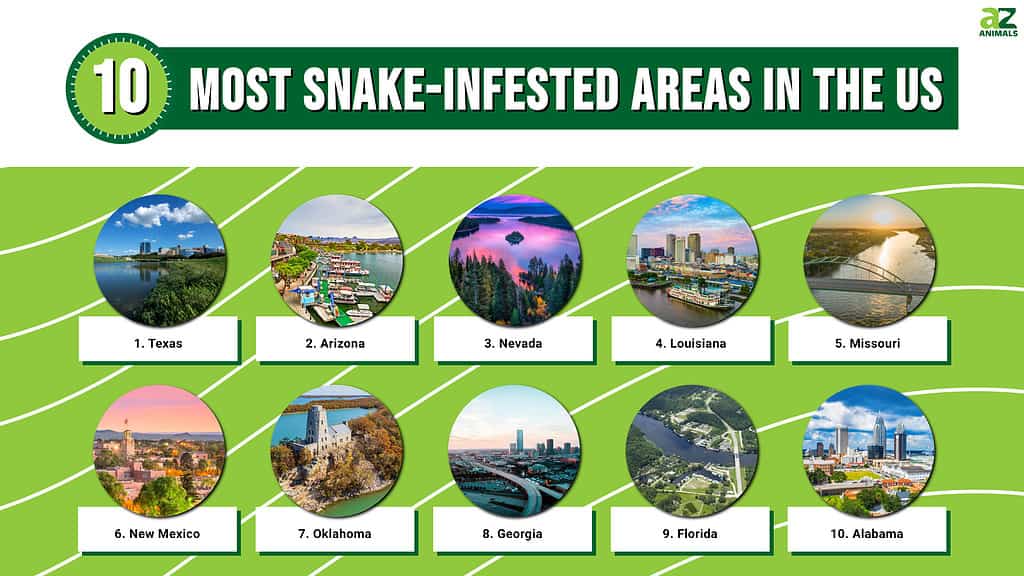
You probably won’t be very surprised to learn that Florida ranks in the top 10 most snake-infested states in the U.S. But where it ranks depends on how many snake species you count. While we’ve stated there are over 50 snake species in Florida, not all of them are native species. According to the Florida Fish and Wildlife Conservation Commission (FWC), there are 44 native snake species in Florida. The rest are invasive species, many inhabiting the swampland of the Florida Keys. If we go with the 44 native species only, Florida ranks 9th for the most snake species in the country.
What state ranks first? That would be Texas, with a whopping 68 snake species! Venomous snakes in the state are several rattlesnake species, copperheads, cottonmouths, and Texas coral snakes. Nonvenomous snakes include the Texas indigo, Texas brown snake, Texas blind snake, and one of the most numerous–the Texas rat snake. The greatest concentration of snakes is in central Texas.
The top 10 most snake-infested states are as follows:
| Rank | State | # of Species |
|---|---|---|
| 1 | Texas | 68 |
| 2 | Arizona | 52 |
| 3 | Nevada | 52 |
| 4 | Louisiana | 48 |
| 5 | Missouri | 47 |
| 6 | New Mexico | 46 |
| 7 | Oklahoma | 46 |
| 8 | Georgia | 46 |
| 9 | Florida | 44 |
| 10 | Alabama | 43 |
The photo featured at the top of this post is © Ryan M. Bolton/Shutterstock.com
Discover the "Monster" Snake 5X Bigger than an Anaconda
Every day A-Z Animals sends out some of the most incredible facts in the world from our free newsletter. Want to discover the 10 most beautiful snakes in the world, a "snake island" where you're never more than 3 feet from danger, or a "monster" snake 5X larger than an anaconda? Then sign up right now and you'll start receiving our daily newsletter absolutely free.
Thank you for reading! Have some feedback for us? Contact the AZ Animals editorial team.






